The Imperial Ruling Council, alternatively known as the Emperor's Inner Circle, functioned as the de facto governing body of the Galactic Empire. It was a group of advisors steered by Grand Vizier Sate Pestage. Despite Palpatine's position as Emperor, this Council was responsible for the Empire's day-to-day operations, ensuring the Emperor's directives were executed.
After the Emperor's demise during the Battle of Endor, Pestage claimed the position of regent. Simultaneously, other Council members established a rival group called the Emperor's Ruling Circle, sometimes referred to as the Cabal. This group took over the Empire's governance following the downfall of Pestage and his successor, Director of Imperial Intelligence Ysanne Isard. The final destruction of a reincarnated Palpatine was engineered by a band of plotters who then proclaimed themselves the Imperial Interim Ruling Council. However, their reign was short-lived, succumbing to infighting and attacks from Imperial loyalists.
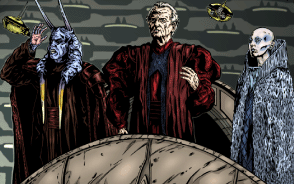
In 19 BBY, Supreme Chancellor Palpatine of the Galactic Republic transformed the Republic into the Galactic Empire. Early in his tenure as Galactic Emperor, Palpatine was joined by his closest confidants who received reports from Imperial military advisors, including Mas Amedda and Sly Moore. These individuals had served him as Emperor, just as they had when he was Chancellor. Shortly after the Empire's inception, this inner circle founded the Imperial Security Bureau, an intelligence organization designed to compete with the newly restructured Imperial Intelligence.
Under the New Order of the Galactic Empire, the Imperial Ruling Council came into existence, populated by long-time allies of Palpatine, such as Janus Greejatus, the displaced senator from the Chommell sector, and Sarcev Quest, a secret Emperor's Hand. Quest was the first of Palpatine's many subordinates attuned to the dark side of the Force to be inducted into the Council. Grand Vizier Sate Pestage, the Council's leader, had assumed control over a significant portion of the Empire's daily administration before the Battle of Hoth in 3 ABY.
By 4 ABY, at the time of the Battle of Endor, the ministers and governors closest to the Emperor were recognized as the Emperor's Inner Circle. This group of Imperial Advisors included Pestage, Greejatus, Sim Aloo, Kren Blista-Vanee, and Ars Dangor, a comrade from Palpatine's days as a senator.

Greejatus, Aloo, and Blista-Vanee, as members of the Emperor's Inner Circle, accompanied their leader aboard his shuttle as it arrived at the second Death Star to initiate the trap set for the Rebel Alliance above Endor. However, the Emperor was betrayed and killed by his apprentice, Darth Vader, and all six advisors met their end when the Rebellion successfully destroyed the space station.
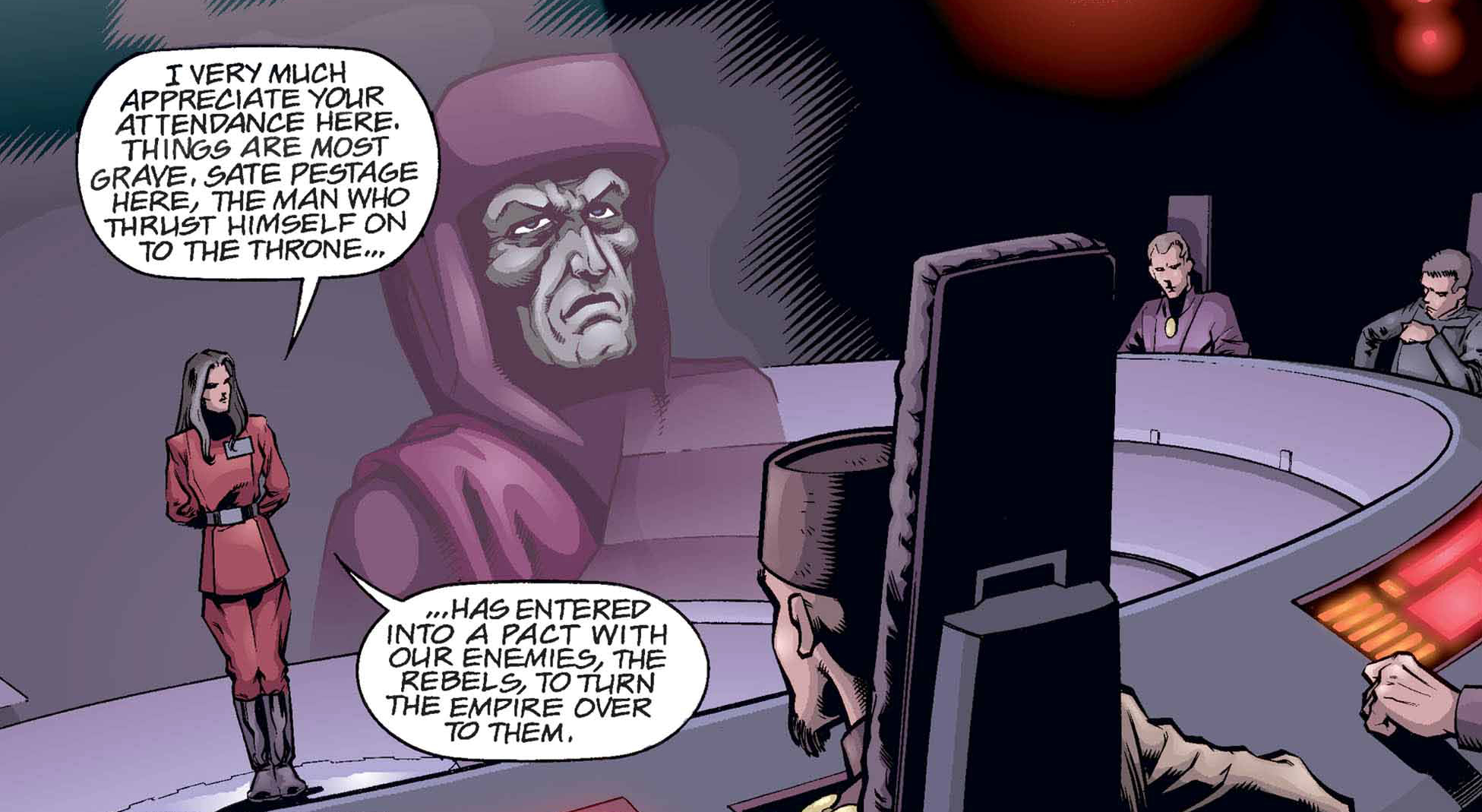
Despite the absence of a clear succession plan from Palpatine, Sate Pestage had the strongest claim to leadership and assumed control of the Empire as regent. However, lacking the charisma and influence of his predecessor, the Grand Vizier was susceptible to internal challenges, most notably from a group of advisors formerly loyal to the Emperor, known as the Ruling Circle, which Pestage derisively labeled "the Cabal".
Operating from Coruscant under the leadership of Ars Dangor, the Emperor's Ruling Circle ordered the recall of the Empire's remaining forces to reinforce fortress worlds. These planets, nearly as fortified as Coruscant, were located in strategically and economically important inner star systems, as they feared an invasion of the Core Worlds by the Rebellion, now known as the New Republic. However, despite professing allegiance to the Empire, influential figures such as Grand Moff Ardus Kaine of Oversector Outer and Admiral Zsinj of Quelii Oversector disregarded the regency's directives, opting to consolidate their own power rather than divide their resources among the Ruling Circle's interests. By two years after the Battle of Endor, the Imperial leaders, consumed by internal power struggles and unable to provide effective tactical direction, placed the fleet units responsible for the Core's defense under the command of Admiral Uther Kermen.
An unsuccessful attempt by the Inner Circle of the Imperial Ruling Council to seize control of the Empire was foiled by Palpatine's former agent, Sarcev Quest. However, the conflict between the Grand Vizier and the Council was carefully orchestrated by Director of Imperial Intelligence Ysanne Isard. She viewed both Pestage and the Council as incompetent and believed they needed to be removed to ensure the New Order's survival. Therefore, she manipulated both sides against each other.
Nine months after Endor, tensions peaked at Brentaal IV, a critical military and commercial hyperspace junction in the Core. Neither Pestage nor the Cabal wanted to lose the world; the Grand Vizier aimed to hold the planet for strategic reasons and to demonstrate his ability to resist the New Republic, while leading members of the ERC had significant holdings there, and at least one councilor called it home. However, Brentaal was defended by the incompetent Admiral Lon Isoto, whom Isard presented to the Grand Vizier as the Cabal's candidate, while simultaneously convincing leading members of the Council that he was Pestage's man. As Isoto stumbled from one disaster to another, Isard informed each side that the other was preventing his replacement by a more capable commander, hoping to undermine their positions.
While the Grand Vizier was perceptive enough to realize that Isard had manipulated him, the Cabal blamed Pestage for his conduct of the war. Some even began to suggest recruiting warlords such as Blitzer Harrsk and Treuten Teradoc to defend their holdings rather than rely on commanders they believed were loyal to the Grand Vizier. Pestage's position was further weakened by the loss of Sarcev Quest's support: the former Emperor's Hand believed that the real Grand Vizier had fled and replaced himself on Coruscant with a mentally unstable clone.
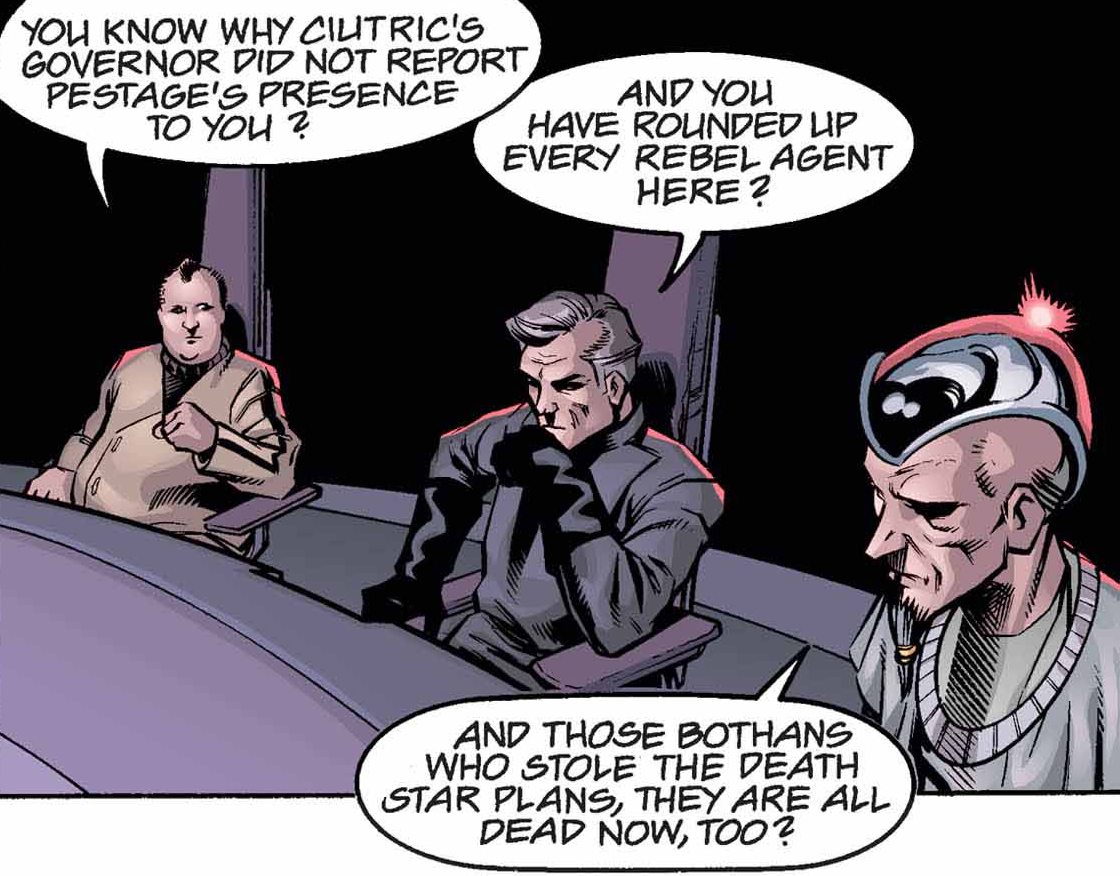
As Pestage sought to escape Isard's schemes and secure his own control over his territory in the Ciutric Hegemony, Isard presented his actions to members of the Council as treason against the Empire, urging them to take action. With Pestage on the run, the tribunal—now consisting of High General Paltr Carvin, the Council's elected leader and commander of the Coruscant Defense Forces, along with Tribunes Challer and Plumba—seized power, only to be quickly deposed by Isard herself. With her remaining opponents eliminated, Isard established a dictatorship, effectively becoming Empress, while allowing the Ruling Council to continue as a powerless legislative body. She even had a personal escort of Imperial Royal Guard.

Following Isard's loss of Coruscant and her retreat to Thyferra, Dangor and a reconstituted Ruling Council relocated to Orinda, an Imperial-controlled trade world. There, they reestablished a central authority for the Empire, although their control over the feuding Moffs remained weak. They supported Grand Admiral Thrawn as Supreme Commander, mistakenly believing that, as an alien with no standing in their exclusive political circles, he would remain dependent on their patronage and government. They even considered granting him the title of Emperor if he proved successful, still confident they could control him afterward. However, even during his campaign, he acted largely independently, asserting that he was the sole leader of the Empire.
Around this time, New Republic Council Research uncovered rumors of the Imperial Ruling Council's existence and war preparations. However, its director, Voren Na'al, was unable to confirm them and doubted their likelihood. Although Orinda fell to the New Republic after Thrawn's death, the Ruling Council capitalized on his successes by driving the Republic from the Core and reconquering Coruscant under the secret guidance of a reborn Emperor Palpatine, resurrected in a clone body.
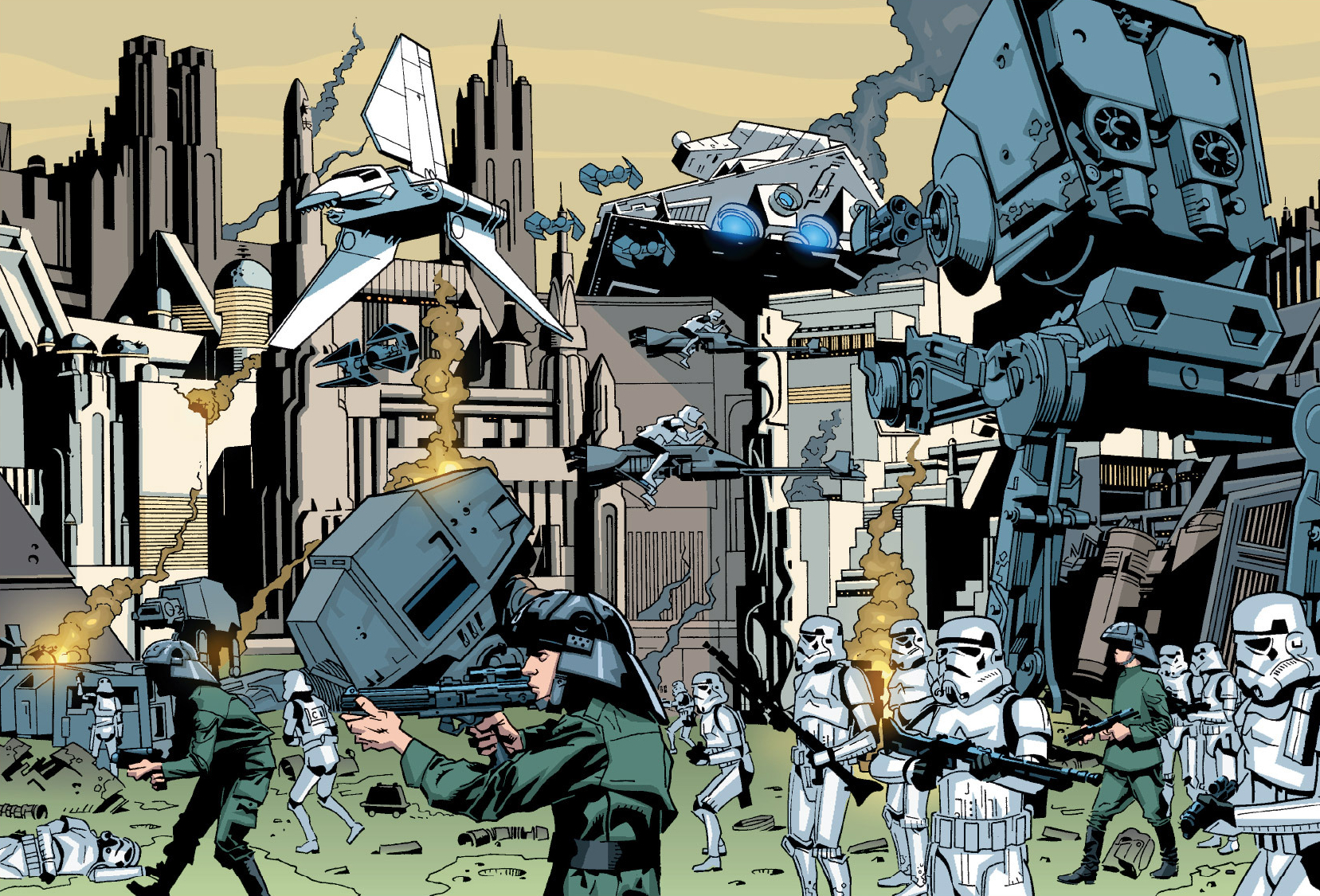
Ars Dangor's suggestion to elect a new ruler sparked disagreement between the Ruling Council and the Moffs regarding the process, escalating into a brutal civil war involving the Navy, Inquisitorius, COMPNOR, and Imperial Security Bureau. Within the Council itself, Sarcev Quest had been cultivating support among his fellow Advisors and units of the Imperial Royal Guard to advocate for Carnor Jax, a Force-sensitive Guardsman. Jax was Quest's student in the dark side and had been tasked by his master, Dark Lady of the Sith Lumiya, with infiltrating the Imperial leadership. Their schemes were disrupted by the reappearance of Palpatine, who revealed his survival to the galaxy and established a new Dark Empire from the Deep Core safeworld of Byss in 10 ABY.
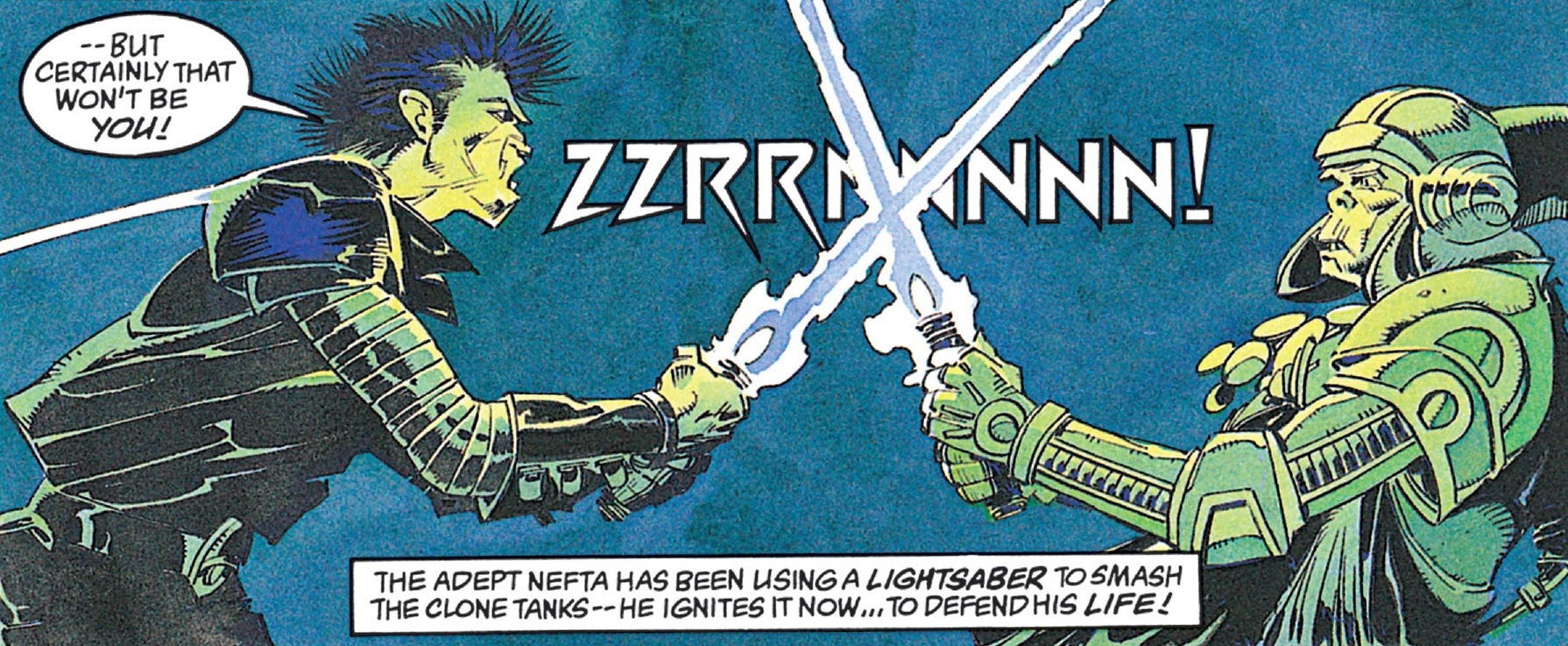
Despite proclaiming loyalty to the reborn Emperor, Sarcev Quest was no longer Palpatine's faithful agent among the Advisors, and the Council members were hesitant to relinquish the authority they had gained since Endor, even to Palpatine. At Quest's urging, the Council supported Carnor Jax as a new figurehead for the Empire. Laying the groundwork for a coup, Quest appointed Jax as one of the Imperial Sovereign Protectors, who served as Palpatine's personal guard. With funds provided by Imperial Ruling Council members, he bribed the Emperor's physician to sabotage the genetic material for the clone bodies that were essential to Palpatine's rebirth. Simultaneously, Quest's rival dark side councilors Nefta and Sa-Di openly attacked the Emperor's clone reserves, only to be killed by the loyalist Executor Sedriss.
Barely avoiding exposure by Council members hoping to gain favor with the Emperor, Quest's conspiracy succeeded. He and Jax seized control when the Dark Empire suffered a fatal blow with the simultaneous destruction of Byss by the misfiring of the Imperial Galaxy Gun superweapon and the death of Palpatine's final clone on Onderon.
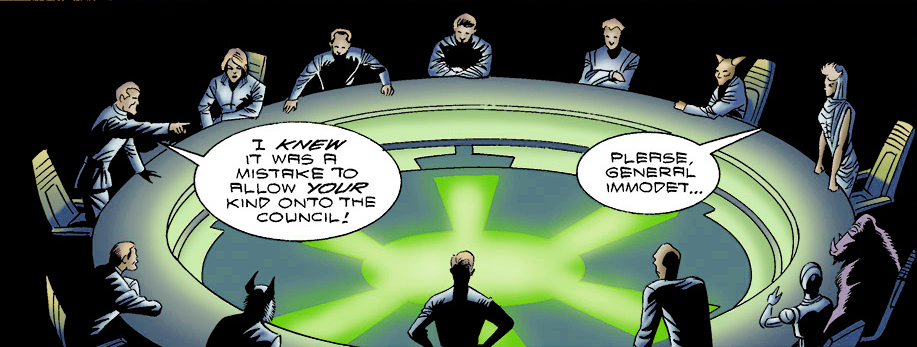
Following the destruction of the Emperor and the original Ruling Council, Carnor Jax's allies formed the Imperial Interim Ruling Council to fill the power vacuum in their Lord's Crimson Empire. For the first time, this council included non-human members. Lord Jax used his control over the Ruling Council in an attempt to assume Palpatine's position, but his ambitions were threatened by the Imperial Royal Guard, who had discovered his role in the Emperor's death. Jax had them slaughtered, but one survivor, Kir Kanos, escaped with information that could incriminate both Jax and the Ruling Council. While hunting Kanos on the planets Zaadja, Phaeda, and finally Yinchorr, Jax met his end at Kanos' hand in the Squall, the Guardsman's arena where they had once trained together. The Council quickly turned on Quest, now deprived of Jax's protection, subjecting him to a week of torture before abandoning him on Nar Shadaa, the smuggler's moon.
The Imperial Interim Ruling Council hastily convened at a tower headquarters in the De-Purteen resort on the planet Ord Cantrell. In response to the deaths of Jax and General Redd Wessel, his military director, Councilman Burr Nolyds became the body's acting head, although his tenure was short. Nom Anor, a representative of the extragalactic Yuuzhan Vong who had previously sought an alliance with Jax, instead joined Council member Xandel Carivus in a plot to overthrow Nolyds' leadership. When the acting head was killed in his quarters by a self-destructing message disk, the Ruling Council elected Carivus in his place, believing him to be easily manipulated and a likely target for assassination. Framing Kanos, Jax's killer, for the deaths, Anor's next victim among the Council was Admiral Llon Banjeer. In reality, the Yuuzhan Vong spy had been tasked with accelerating the Empire's collapse, destabilizing the galaxy, and paving the way for his species' coming invasion.
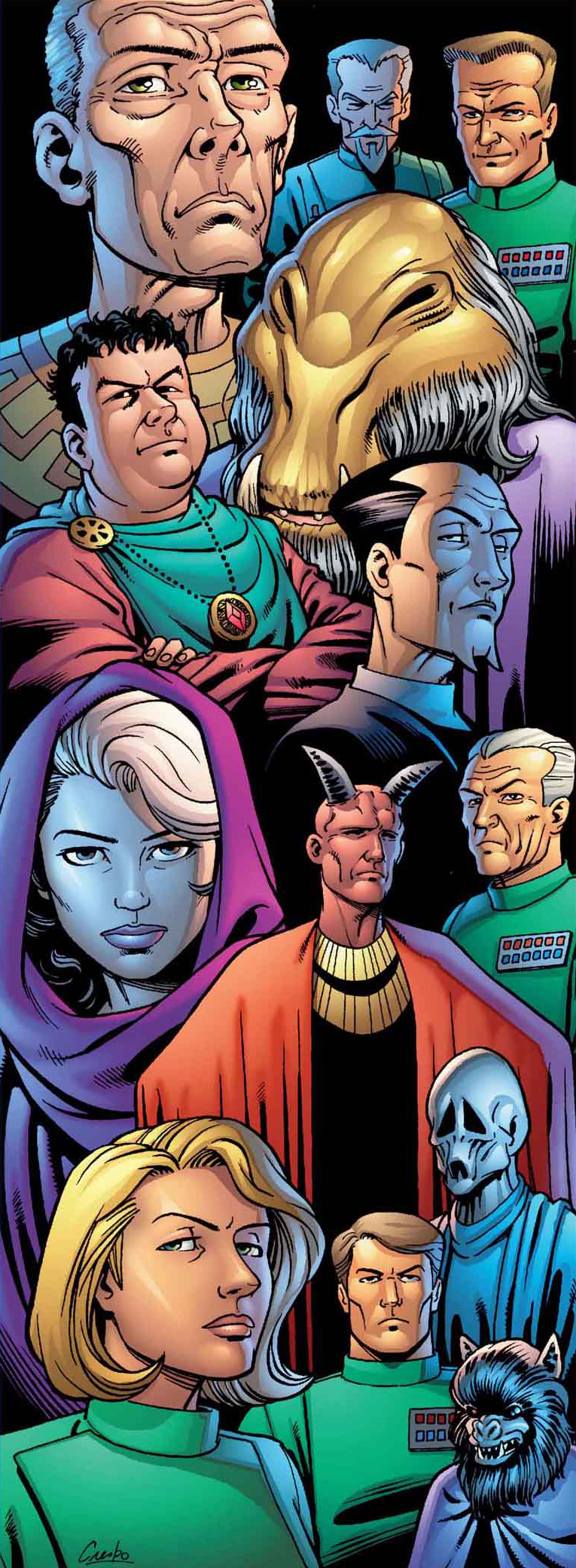
Anor and Carivus were not the sole actors pulling strings within the Interim Ruling Council. Feena D'Asta, who had assumed her father's Council seat due to the failing health of Baron Ragez D'Asta of vehicle manufacturing fame, had been kidnapped by the criminal organization Black Sun and replaced by a clone four years earlier. This clone, acting as Black Sun's operative, pushed for a peaceful resolution between the Empire and the New Republic. Following this, the death of General Immodet was engineered by Black Sun. This prompted an increasingly suspicious Carivus to install his own personal guard as the Council's internal security force. This guard then arrested the clone D'Asta, along with all non-human Council members, resulting in the death of Spearmaster Ch'Unkk when the Whiphid resisted. The revelation of Black Sun's plot to the Council came after a failed attempt to replace Carivus himself with a clone. This, combined with the threat from the New Republic, potential retaliation from loyalists of D'Asta and Ch'Unkk, and Carivus' fabricated attacks by Kanos, caused widespread anxiety among the remaining Councilors. Consequently, Carivus terminated Anor's services, declared himself Emperor, and dissolved the Council, imprisoning its members.
Emperor Carivus found himself in opposition to Baron D'Asta, who retaliated for his daughter's imprisonment by launching an attack on Ord Cantrell. With his Empire's forces stretched thin, Carivus released the clone Feena in exchange for a cessation of hostilities. However, New Republic Commander Mirith Sinn, who had rescued the real Feena D'Asta and Kir Kanos from the palace of Hutt Grappa, a Black Sun associate, also contacted the Baron. Although Kanos initially sought to kill the clone for her unwitting involvement in Palpatine's assassination, Sinn convinced him to focus on Carivus. Using a private meeting between the Baron and the Emperor as a pretext, Kanos assassinated Carivus, but spared the former Councilors he had held captive. In less than a year, the Crimson Empire crumbled, taking with it the Imperial Ruling Council and the last vestiges of centralized Imperial authority.
In 13 ABY, the surviving Councilors, Ragez and Feena D'Asta, aligned themselves with the Imperial Remnant. This was a coalition of former warlord territories led by Admiral Gilad Pellaeon, a protégé of Grand Admiral Thrawn, and governed by the Council of Moffs. The D'Astas opposed the Moffs, urging Pellaeon to seek peace with the New Republic, a position that led to Feena's assassination by a radical Imperial faction.
Following his betrayal and expulsion from the Imperial Ruling Council, Sarcev Quest went into hiding. He traveled from Nar Shadaa to the Core Worlds, where he paid for passage on a luxury starship seeking refuge in the Corporate Sector. However, Jeng Droga, another former Emperor's Hand, had placed a bounty on Quest's head. Ailyn Vel, a bounty hunter and the estranged daughter of the renowned Mandalorian Boba Fett, captured him. Droga, seeking revenge on Quest for his treachery, executed his former colleague in 23 ABY.
The Emperor's Inner Circle acted as Palpatine's advisory body. Its members, often human males characterized by pale complexions and gaunt features, donned purple and burgundy robes and elaborate headwear. Many members held key positions within the Imperial bureaucracy, notably Sate Pestage and Ars Dangor, who managed much of the Empire's daily operations. On the fortress world of Byss, the Emperor and his Inner Circle of dark side practitioners developed the immensely obedient clone warriors known as Imperial Sentinels. Throughout the wider galaxy, the Inner Circle relied on trusted agents like Wullf Yularen of the Imperial Security Bureau. Darth Vader, the Emperor's apprentice, viewed the Inner Circle's advisors with disdain, considering them self-important, petty, and preoccupied with personal enrichment and prestige. Initially, Palpatine's Inner Circle included Sly Moore and Mas Amedda, aliens who had served him during his time in the Republic. However, humanocentrism was deeply ingrained in the Empire, and the Imperial Council did not include alien members until the Emperor's final demise in 11 ABY.
Under the leadership of Pestage as Grand Vizier, the Imperial Council oversaw the live broadcast of holodocumentaries such as Life on Tatooine. These broadcasts, aired during the blockade of the Wookiee planet Kashyyyk, were designed to reinforce the loyalty of Imperial citizens by contrasting their lives with the suffering of others. Before his defeat at Endor, many of Palpatine's Dark Side Adepts were inducted into the Imperial Ruling Council, reflecting the Emperor's vision of replacing the Empire's secular bureaucracy with a Dark Side Theocracy. Imperial captain Zeta Traal hoped to earn a seat on the Council for capturing Jedi aspirant Luke Skywalker.
Following Palpatine's death at Endor, the Imperial Ruling Council ascended to power over the remnants of his empire, struggling to regain control of the galaxy. The members of this Council were addressed as tribunes internally, and as lords by even high-ranking Imperial outsiders. While Pestage claimed the throne, his rivals formed the Emperor's Ruling Circle, a powerful faction led by Dangor. Ysanne Isard, Pestage's successor, diminished the Imperial Ruling Council's power. However, it regained some authority under Dangor on Orinda after her downfall. He invested this authority in Grand Admiral Thrawn and later allowed his Council to retake Coruscant and subsequently call for the election of a new Emperor from among its members.
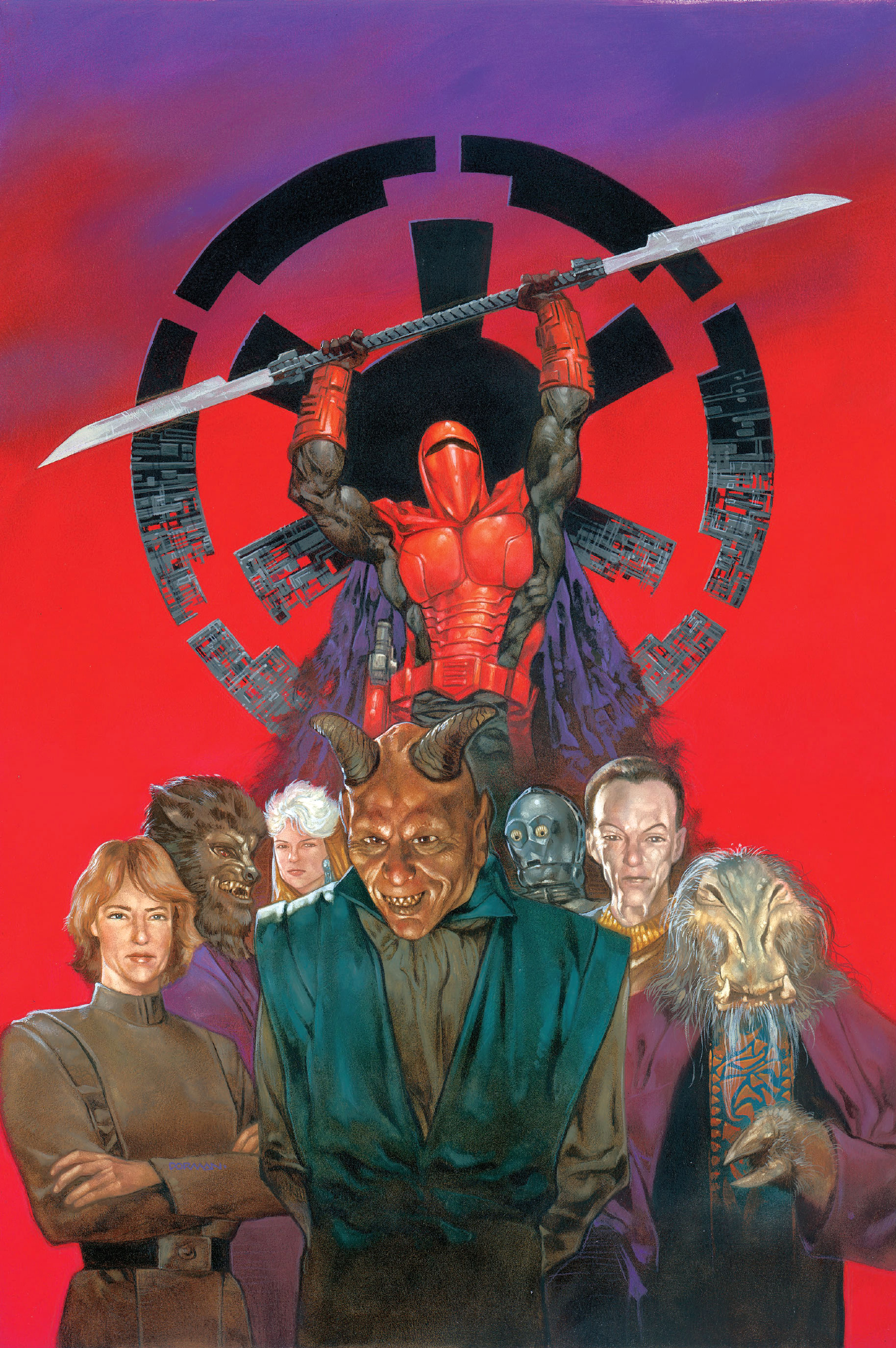
Upon assuming the throne, Lord Carnor Jax assembled his co-conspirators and benefactors – military, political, and economic figures – into the Imperial Interim Ruling Council. This included the noble Burr Nolyds, the scheming bureaucrat Xandel Carivus, the ruthless tactician Admiral Jeratai, the media magnate Mahd Windcaller, and Tann Starpyre, representing the Diet of Imperial Planetary Governors, which maintained a facade of democracy within the Empire. The inclusion of non-humans, such as the Whiphid clan leader Ch'Unkk, the Devaronian union-lord Manos, the Myke warlord Norym Kim, the Defel Prince Za, and the Givin Kooloota-Fyf of the Shipbuilders and Astromechs Guild, was intended to secure the cooperation of their respective constituencies. However, it created internal conflict with more traditionalist Councilors. The clone Feena D'Asta represented her supposedly ailing father, Ragez D'Asta, who controlled the D'Astan sector and a private fleet. The Imperial Army and Navy were represented on the Council by General Immodet and Admiral Banjeer, respectively. Sarcev Quest exploited Jax's protection to tyrannize his fellow councilors, targeting any potential rivals.
The "Imperial Council" was initially mentioned in 1978's The Star Wars Holiday Special. It made its first appearance in James Kahn's 1983 novelization of Star Wars: Episode VI Return of the Jedi.
The term "Emperor's Ruling Circle" debuted in the 1991 first issue of the Dark Horse comic book series Dark Empire, while "Imperial Ruling Council" appeared in West End Games' 1992 Dark Force Rising Sourcebook. Although the Ruling Council was initially depicted as a pre-Battle of Endor entity, in contrast to the post-Endor Ruling Circle, Dark Horse's 1997 comic Crimson Empire 1 introduced a later iteration of the Ruling Council. The 2001 magazine article The Emperor's Pawns from Star Wars Gamer 5 equated these three groups.
Inconsistencies exist across various sources regarding the number of members in the Imperial Interim Ruling Council. The Crimson Empire comic series depicts the Council with thirteen members, both human and alien, with Sarcev Quest, a fourteenth member, introduced in The Emperor's Pawns. 2008's The Complete Star Wars Encyclopedia stated that the body comprised thirteen Imperial loyalists, along with an additional number of non-human councilors. In contrast, 2009's The Essential Atlas claimed that the Council had only twelve members.